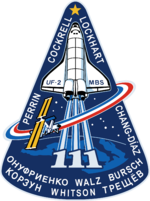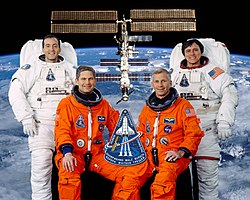STS-111
| Mission emblem | |||
|---|---|---|---|

|
|||
| Mission dates | |||
| Mission: | STS-111 | ||
| COSPAR-ID : | 2002-028A | ||
| Crew: | 7th | ||
| Begin: | June 5, 2002, 21:22:49 UTC | ||
| Starting place: | Kennedy Space Center , LC-39A | ||
| Space station: | ISS | ||
| Coupling: | June 7, 2002, 16:25:00 UTC | ||
| Decoupling: | June 15, 2002, 14:32:00 UTC | ||
| Duration on the ISS: | 7d 22h 7min 0s | ||
| Number of EVA : | 3 | ||
| Landing: | June 19, 2002, 17:57:41 UTC | ||
| Landing place: | Edwards Air Force Base , Runway 22 | ||
| Flight duration: | 13d 20h 34min 52s | ||
| Earth orbits: | 217 | ||
| Track height: | Max. 387 km | ||
| Covered track: | 9.3 million km | ||
| Payload: | MPLM Leonardo , part of the Mobile Base System | ||
| Team photo | |||
 v. l. No. Front: Paul Lockhart, Kenneth Cockrell; Back: Philippe Perrin, Franklin Chang-Diaz |
|||
| ◄ Before / After ► | |||
|
|||
STS-111 ( english S pace T ransportation S ystem ) is the mission designation for a flight of the US Space Shuttle Endeavor (OV-105) of NASA . The launch took place on June 5, 2002. It was the 110th space shuttle mission, the 18th flight of the space shuttle Endeavor and the 14th flight of a shuttle to the International Space Station (ISS).
team
Shuttle crew
- Kenneth Cockrell (5th space flight), commander
- Paul Lockhart (1st space flight), pilot
- Franklin Chang-Diaz (7th spaceflight), mission specialist
-
Philippe Perrin (1st Space Flight), Mission Specialist ( CNES / France )

(Chang-Diaz was the second spaceman to complete seven missions. Jerry Ross first set this record two months earlier )
ISS crew outward flight
-
Valery Korsun ( Roskosmos / Russia ) (2nd space flight), commander

- Peggy Whitson (1st spaceflight), flight engineer
-
Sergei Treschtschow ( Roskosmos / Russia ) (1st space flight), flight engineer

replacement
-
Alexander Kaleri ( Roskosmos / Russia ) for Korsun

- Scott Joseph Kelly for Whitson
-
Dmitri Kondratjew ( Roskosmos / Russia ) for Treschew

ISS crew return flight
-
Yuri Onufrijenko ( Roskosmos / Russia ) (2nd space flight), commander

- Daniel Bursch (4th space flight), flight engineer
- Carl Walz (4th space flight), flight engineer
(Returned to Earth after a flight time of 195 days, 19 hours and 39 minutes; one-way flight on STS-108 )
Mission overview
The Endeavor delivered the last component with which the Mobile Base System (MBS), the transport system supplied by STS-110 , could be completed. With its help, the Canadarm2 was able to move significantly faster over the station. Furthermore, new experiments for the scientists with the multipurpose logistics module (MPLM) Leonardo were delivered. A crew change also took place on board the ISS. A total of three EVAs were carried out by Chang-Diaz and Perrin while the Endeavor was connected to the ISS.
Mission history
After take-off and approach maneuvers, the Endeavor docked with the bow of the station on June 7, 16:25 UTC. About 3 hours after docking, the hatches were opened and work began. At the beginning the bucket seats in the Soyuz spaceship were changed and various handover procedures went through.
On June 8, the Leonardo transport module was released from the shuttle's loading bay and docked on the underside of Unity . On this flight there were 2 standard racks as well as 8 shelves and 5 platforms in the module, which were filled with supplies, experiment materials and spare parts. 3.7 tons of cargo were unloaded within 4 days. In addition, the two racks were brought into the Destiny laboratory module and connected. EXPRESS-Rack 3 had a vibration-damped experiment platform of the ARIS (Active Rack Isolation System) type. Here investigations could be carried out in which disturbances of the weightlessness by the movements of the space travelers or by orbit maneuvers would endanger the results of the experiments. The second rack contained the Microgravity Science Glovebox (MSG), a hermetically sealable glove box for experiments under microgravity and the associated supply and control systems.
Several experiments were also transported to the station from the middle deck of the space shuttle. These included the Advanced Astroculture (ADVASC) greenhouse, the KSC Nitrogen Freezer, the commercial generic biotechnology apparatus (CGBA), Protein Crystal Growth - Single locker Thermal Enclosure System (PCG-STES) for obtaining the purest possible protein crystals and the Commercial Refrigerator / Incubator Module (CRIM). In the opposite direction, 2.1 tons of material were transferred to the Leonardo logistics module and around 0.5 tons of completed experiments were transferred to the shuttle. This included the results of biotechnological, medical, physical and geophysical investigations (e.g. PESTO, Protein Crystal Growth-Enhanced Gaseous Nitrogen Dewar, CGBA, CPCG). Leonardo was stowed back in the Endeavor's payload bay on June 14th.
On June 9, Chang-Diaz and Perrin climbed out of the station for 7 hours and 14 minutes using the Quest module and did various jobs. First, a gripping coupling was attached to the grid element P6. The station's manipulator can dock here when P6 is moved to its final position. Perrin then transported 6 meteorite protection covers from the Endeavor's loading bay to the PMA-1 connecting tunnel. The covers should end in July of two members of the crew on the service module Zvezda be mounted. Chang-Diaz and Perrin then inspected and photographed a gyroscope top that had failed the day before and finally removed protective covers from the Mobile Remote Servicer Base System (MBS for short) in the shuttle's loading bay. After the outboard work had been completed, this was lifted out of the loading bay with the station manipulator and transported near its final position for thermal adjustment, but not yet docked. The latter only happened on June 10 at 13:06 UTC.
The Mobile Base System is a movable work and storage platform that can operate on the mobile transporter along the lattice structure. It has 4 redundant docking points for the Canadarm2 station manipulator (Power and Data Grapple Fixture) and a gripper for heavy loads. In addition, containers with tools and other materials can be deposited on it. The entire platform can be surveyed via a video camera. The MBS is made of aluminum, has its own control system and is connected to the mobile transporter with 4 strong bolts. The platform is about 5.70 meters long, 4.50 meters wide, 2.90 meters high and has a mass of 1.5 tons. It can be used to transport masses of up to 20.9 tons. The maximum electrical power consumption is 825 watts. The cost of the (interchangeable) structure was $ 254 million.
The crew change of the International Space Station also took place on June 10th. Valeri Korsun, Peggy Whitson and Sergej Treschtschow moved to the station as ISS expedition 5, Juri Onufrijenko, Daniel Bursch and Carl Walz took their places on board the Endeavor.
On June 11th, Chang-Diaz and Perrin secured the 4 connecting bolts of the Mobile Base System on the Mobile Transporter and connected several energy, data and video cables with an exit that took exactly five hours. A load carrier was moved to its regular position and a camera changed position. With it, the entire work and storage platform can be seen.
On June 13, Chang-Diaz and Perrin exchanged a wrist roll on the Canadian manipulator arm of the station on their third exit (7:17 h). A short circuit was found in the control of this joint, but this only affected one control channel. Each element has two redundant controls. It is connected to the neighboring elements with 6 mechanical bolts. A seventh bolt secures the energy, data and video connection. In the last few months, the control problem was circumvented by adapting the software. Nevertheless, the segment in question was changed to prevent a possible total failure.
In the course of the joint flight, the orbit of the complex was raised by about 10 kilometers due to the shuttle's engine ignitions. On June 15 at 14:32 UTC, the Endeavor detached itself from the station, circled it and then moved further away from it. During the orbit, photo and video recordings were made to document the progress of the work.
In addition to several press conferences, some routine scientific investigations were also carried out. Most of them related to biomedical problems (day-night rhythm, virus reactivation, function of the human immune system , testing of preventive drugs against orthostatic hypotension , changes in spatial orientation, eye movements) and technical systems (recording of the flight path with precise GPS data, Crosswind influence on landing). For the first time there was a new system for cleaning the water that is created in the fuel cells during the flight. The Biotechnology Water Treatment System achieves a higher degree of purity than the previous equipment. On June 16, the correction engines were ignited for 10 seconds in order to examine the smoke plumes that were generated. There were special sensors on board the shuttle for this purpose.
The return was postponed several times due to bad weather at the intended landing site. The Endeavor finally landed in Edwards (California, USA) after a nearly 14-day flight.
See also
Web links
- NASA Mission overview (English)
- NASA official page of the Mission (English)
- NASA video of Mission (English)
- Video summary with comments of the crew (English)


